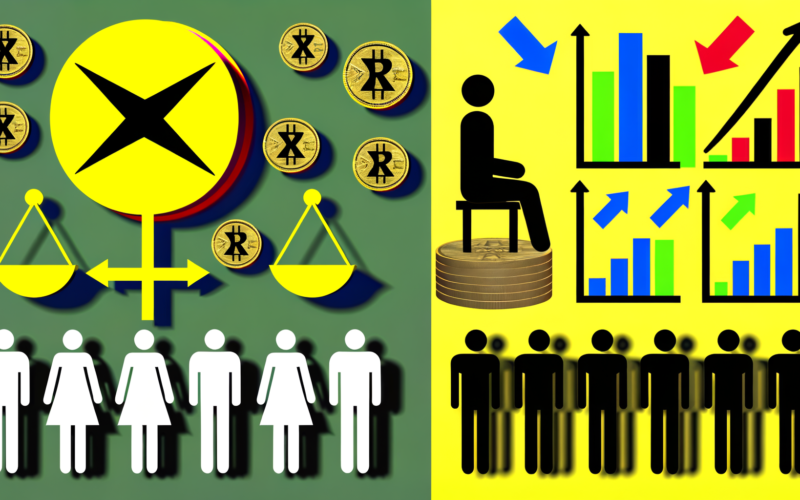Ripple’s RLUSD benefits from the GENIUS Act, but minimal impact on XRP. Regulatory clarity could redefine its role. #CryptoNews #Ripple #XRP
- Introduction
- The Evolution of Cryptocurrency Regulation in the U.S.
- Main Insights on the GENIUS Act and Ripple’s Position
- Challenges and Opportunities in the Cryptocurrency Landscape
- Future Outlook: What Lies Ahead for Ripple and XRP
- Final Reflections on Ripple and XRP: Navigating the Crypto Ecosystem
Introduction
Exploring the GENIUS Act: What It Means for Ripple and XRP
On a recent Friday, the United States took a decisive step toward integrating cryptocurrency more deeply into its economy with the signing of the GENIUS Act by President Donald Trump. This legislation is poised to create new pathways for stablecoin issuers, such as Ripple, to thrive under a regulated framework. Yet, for XRP investors, the question remains: How will this new law impact their investments? While the act seems to favor stablecoins like Ripple’s RLUSD, experts suggest its direct impact on XRP could be limited. This article delves into the implications of the GENIUS Act, exploring its benefits for Ripple, the potential effects on XRP, and the broader landscape of cryptocurrency regulation in the U.S.
Ripple, with its established cross-border solutions, is uniquely positioned to leverage this new legal environment. However, the road for XRP is not as straightforward. As you read on, you’ll discover the nuanced benefits and challenges presented by the GENIUS Act, along with expert insights on what this means for the future of XRP and Ripple’s strategic positioning.
The Evolution of Cryptocurrency Regulation in the U.S.
Cryptocurrency regulation in the U.S. has evolved significantly over the past decade, reflecting the growing importance of digital assets in the financial ecosystem. Initially viewed with skepticism, cryptocurrencies have gradually gained legitimacy, prompting lawmakers to address regulatory gaps. The GENIUS Act represents a key milestone in this journey, providing a clearer framework for stablecoin operations.
Historically, the U.S. regulatory approach to cryptocurrencies has been fragmented, with various agencies offering differing interpretations. The Securities and Exchange Commission (SEC) and the Commodity Futures Trading Commission (CFTC), for instance, have sometimes clashed on whether specific digital assets are securities or commodities. This regulatory ambiguity has often left investors and companies in limbo.
The GENIUS Act seeks to address some of these inconsistencies, particularly concerning stablecoins, by establishing a regulated path for their use and issuance. This act could set a precedent for future legislation, potentially influencing how other digital currencies, including XRP, are treated under U.S. law.
Main Insights on the GENIUS Act and Ripple’s Position
1. Ripple’s Stablecoin Advantage:
The GENIUS Act offers a competitive edge to stablecoins like Ripple’s RLUSD. By providing a regulated environment, the act facilitates institutional adoption, which is crucial for mainstream acceptance. According to Austin King, co-founder of Omni Network, “Ripple is uniquely positioned to benefit from this new legislation,” as it allows RLUSD to emerge as a native liquidity provider in the U.S. financial system.
2. Minimal Direct Impact on XRP:
Despite the advantages for RLUSD, the direct impact on XRP remains minimal. While each RLUSD transaction burns a small amount of XRP, the effect on XRP’s vast circulating supply is negligible. With over 59.1 billion XRP tokens in circulation, the cumulative burn of 14 million tokens since inception has little effect on its market value. Ripple CTO David Schwartz has previously stated that the burned XRP won’t significantly reduce the supply anytime soon.
3. Strategic Positioning Amid Regulatory Challenges:
The ongoing SEC vs. Ripple lawsuit continues to cast uncertainty over XRP’s classification as a security. This legal battle highlights the regulatory challenges that Ripple faces. However, the GENIUS Act enables Ripple to strategically reduce its reliance on XRP by leveraging RLUSD, allowing for a reconfiguration of its operations within the U.S. financial landscape.
4. The Role of RLUSD in Cross-Border Transactions:
Ripple’s RLUSD could enhance its cross-border payment solutions, offering a stable and regulated alternative to existing options like USDC and PayPal USD. By becoming a core infrastructure provider, Ripple positions itself to compete directly with established players in the stablecoin market.
5. Potential for Broader Tokenization Strategies:
If future legislation, such as the proposed CLARITY Act, is adopted, it could provide clarity for XRP’s classification. This would eliminate ambiguity and open doors for broader tokenization strategies, enabling Ripple to expand its offerings beyond traditional cryptocurrency markets.
Challenges and Opportunities in the Cryptocurrency Landscape
Navigating Regulatory Uncertainty:
One of the primary challenges facing cryptocurrency companies is navigating the complex regulatory environment. The classification of digital assets as securities or commodities remains a contentious issue, and regulatory bodies continue to refine their approaches. This uncertainty can hinder innovation and deter investment.
Adapting to Competitive Pressures:
Ripple faces competition from other stablecoin issuers like Circle’s USDC and Tether’s USDT. As these competitors vie for market share, Ripple must leverage its established network and cross-border expertise to maintain its competitive edge.
Seizing Institutional Opportunities:
The GENIUS Act opens new doors for institutional adoption of stablecoins. By capitalizing on these opportunities, Ripple can strengthen its position as a leading provider of digital asset solutions, fostering greater trust and acceptance among financial institutions.
Mitigating Legal Risks:
Ongoing legal battles, such as the SEC lawsuit, present significant risks to Ripple and XRP. Proactively addressing regulatory concerns and engaging with policymakers can help mitigate these risks and pave the way for a more favorable regulatory environment.
Future Outlook: What Lies Ahead for Ripple and XRP
Emerging Trends in Stablecoin Regulation:
The GENIUS Act may serve as a model for future legislation, setting the stage for more comprehensive regulation of digital assets. This could lead to increased stability and predictability in the market, encouraging further investment and innovation.
The Potential Impact of the CLARITY Act:
If adopted, the CLARITY Act could provide the legal clarity needed for XRP’s classification, reducing regulatory hurdles and enabling Ripple to expand its tokenization strategies. This would enhance Ripple’s ability to explore new markets and applications for its technology.
Ripple’s Role in the Digital Economy:
As cryptocurrency continues to gain traction, Ripple’s role in the digital economy is likely to expand. By leveraging its expertise in cross-border payments and stablecoins, Ripple can position itself as a key player in the evolving financial landscape.
In conclusion, the GENIUS Act represents a significant development in the regulation of digital assets, offering new opportunities for stablecoins like Ripple’s RLUSD. However, its direct impact on XRP remains limited, with broader implications dependent on future regulatory developments.
For XRP investors, understanding the nuances of these regulatory changes is crucial. While the GENIUS Act may not immediately influence XRP’s price, it sets the stage for potential growth and innovation within Ripple’s ecosystem. By strategically navigating regulatory challenges and capitalizing on new opportunities, Ripple can continue to thrive in the dynamic world of cryptocurrency.
As the landscape evolves, staying informed and adaptable will be key to success. Ripple’s journey underscores the importance of balancing innovation with compliance, ensuring that it remains at the forefront of the digital asset revolution.
With the potential for further regulatory clarity through initiatives like the CLARITY Act, the future of Ripple and XRP holds promise. By embracing these changes and leveraging its strengths, Ripple can continue to redefine the boundaries of finance and technology.











